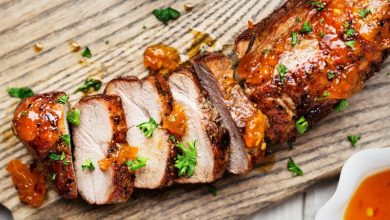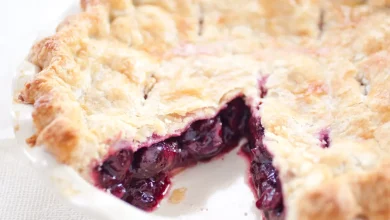🍲 Anything Goes Casserole 🍲
Anything Goes Casserole is a versatile and comforting dish that lives up to its name. It’s a popular American casserole that allows you to use whatever ingredients you have on hand, making it a great way to use up leftovers and create a delicious, one-dish meal. Here’s a detailed breakdown of this dish:
📜 History:
The history of Anything Goes Casserole is somewhat vague, as it’s more of a concept than a specific recipe. Casseroles, in general, have been a staple of American home cooking for generations. They gained popularity in the mid-20th century due to their convenience and the ability to feed a family with simple ingredients. Anything Goes Casserole is a modern twist on this tradition, emphasizing creativity and resourcefulness in the kitchen.
🥘 Components:
The beauty of Anything Goes Casserole is that you can use a wide variety of ingredients. However, a basic version might include:
- Protein: Ground beef, chicken, turkey, or sausage.
- Vegetables: Bell peppers, onions, tomatoes, corn, peas, carrots, or whatever vegetables you prefer.
- Starch: Pasta, rice, or potatoes.
- Sauce: Tomato sauce, cream soup (like cream of mushroom or cream of chicken), or a cheese sauce.
- Seasonings: Salt, pepper, herbs, and spices to taste.
- Toppings: Cheese, breadcrumbs, or crushed crackers for a crunchy topping.
👩🍳 Preparation:
Here’s a step-by-step guide to making Anything Goes Casserole:
-
Preheat the Oven: Preheat your oven to 350°F (175°C).
-
Cook the Protein: In a skillet, cook the chosen protein until it’s no longer pink. Drain any excess fat.
-
Prepare the Vegetables: Sautee the vegetables in the same skillet until they become tender. Season with salt and pepper.
-
Cook the Starch: Cook the starch (pasta, rice, or potatoes) according to package instructions. Drain.
-
Combine Ingredients: In a large mixing bowl, combine the cooked protein, vegetables, starch, and your chosen sauce. Mix well to ensure everything is evenly coated.
-
Season: Season the mixture with your preferred herbs and spices to taste. This is where you can get creative and add your favorite flavors.
-
Transfer to a Casserole Dish: Grease a casserole dish and transfer the mixture into it.
-
Add Toppings: Sprinkle cheese, breadcrumbs, or crushed crackers on top for a crispy topping.
-
Bake: Cover the casserole dish with foil and bake in the preheated oven for about 25-30 minutes. Then, remove the foil and bake for an additional 10-15 minutes or until the top is golden and bubbly.
-
Serve: Let it cool for a few minutes, and then serve your delicious Anything Goes Casserole!
⏰ Time Needed:
The total time needed to prepare Anything Goes Casserole can vary depending on the ingredients you use and your experience in the kitchen. On average, it takes about 1.5 to 2 hours from start to finish, including prep time and baking.
Enjoy your meal, and feel free to get creative with your Anything Goes Casserole by using your favorite ingredients and seasonings! 🍽️👨🍳👩🍳👌
Certainly! Here are some general nutrition facts and health considerations for Anything Goes Casserole:
Nutrition Facts (Per Serving, Approximate):
- Calories: Varies depending on ingredients used (typically 300-500 calories per serving).
- Protein: Varies based on protein source (15-25 grams per serving).
- Carbohydrates: Varies depending on starch choice (30-50 grams per serving).
- Dietary Fiber: Depends on vegetable content (2-5 grams per serving).
- Fat: Varies depending on protein and sauce (10-20 grams per serving).
- Sodium: Can be high due to seasoning and sauce (500-800 mg per serving).
Health Considerations:
-
Caloric Intake: The calorie content of Anything Goes Casserole can vary widely based on ingredients used. Be mindful of portion sizes to manage your caloric intake, especially if you’re watching your weight.
-
Protein Source: Choose lean protein sources like turkey, chicken, or lean ground beef to reduce saturated fat content.
-
Starch Choice: Opt for whole grains like whole wheat pasta or brown rice for added fiber and nutrients.
-
Vegetables: Incorporate a variety of vegetables to boost the nutritional value of your casserole. They provide essential vitamins, minerals, and fiber.
-
Sauces: Be cautious with creamy sauces, as they can be high in saturated fat and calories. Consider using low-fat or Greek yogurt as a healthier alternative.
-
Sodium: Be mindful of the salt content, as canned soups and sauces can contain a significant amount of sodium. Use low-sodium options or season with herbs and spices to reduce sodium intake.
-
Toppings: Limit the use of high-fat toppings like excessive cheese or buttered breadcrumbs to keep the dish healthier.
-
Customization: The healthiness of your casserole depends largely on the choices you make when selecting ingredients. Customize it to fit your dietary preferences and nutritional goals.
Remember that the nutritional values can vary widely depending on your specific recipe and ingredient choices. If you have specific dietary concerns or health goals, it’s a good idea to calculate the exact nutrition facts based on the ingredients you use or consult with a registered dietitian for personalized guidance.




